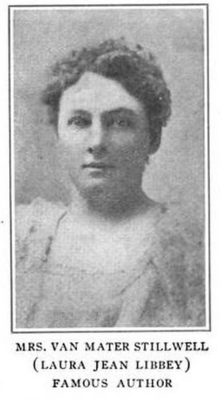Laura Jean Libbey
Laura Jean Libbey (March 22, 1862 – October 25, 1924), was an American writer.


Biography
Libbey lived most of her life in Brooklyn, New York.[1] Her parents were Thomas and Elizabeth Libbey.[2] She began writing around age 20.[1] Over the course of her career, she completed 82 novels.[1]
Some of Libbey's stories first appeared as serialized stories in papers such as The New York Family Story Paper, The Fireside Companion, and the New York Ledger.[1] During the 1880s her stories were popular enough for Libbey to negotiate high paying exclusive contracts with specific papers.[3] These serialized stories were later reprinted in dime novel format by publishers of cheap fiction such as George Munro, Arthur Westbrook, and John Lovell.[1]
Over fifteen million copies of her books were published.[3] According to The American Bookseller, Libbey's 1889 The Pretty Young Girl was "the hit of the season" in selling 60,000 copies in thirty days.[4] At one point, Libbey reported she was earning $60,000 a year, but this number may have been exaggerated.[1][3]
Three of Libbey's stories were made into films: When Love Grows Cold (1926), A Poor Girl's Romance (1927), and In a Moment of Temptation (1928).[5][6][7][8] Libbey also wrote 120 plays, many based on her previously published stories.[3]
Known as the "working-girl" novelist[9], Libbey's stories were romances about employed young women without family support.[1] Her earliest stories (published in the 1880s) were moralistic and focused on the difficulties of factory work. [3] The stories published in the 1890s and 1900s focused more on the process of finding an appropriate romantic partner.[3]
According to Joyce Shaw Peterson, Libbey's heroines show signs of being proto-feminists.[10] They work for a living, they are spirited, they are proud, they have integrity.[10] When abducted they often manage to run away on their own.[10] However, their permanent safety always depends upon male protection.[10] There is no female solidarity in Libbey's stories, other women are jealous rivals for the attentions of men.[10] Employment is an opportunity to find a wonderful husband, not a chance to find freedom and self-definition.[10] Overall, Libbey's stories were outside the feminist stream of the time which focused on economic independence.[10]
Libbey also worked as an editor.[1] From 1891 to 1894 she edited George Munro’s Fashion Bazaar.[1] Her financial records indicate that she received $10,400 a year for her editorial work.[1]
Supposedly Libbey's mother forbade her from marrying.[1] Two years after Libbey's mother passed away in 1896 she married a Brooklyn lawyer by the name of Van Mater Stilwell.[1] Libbey was 36 years old when she married.[1]
Libbey died in 1924 after complications from cancer surgery.[1] She is buried in Green-Wood Cemetery in Brooklyn.[8] Libbey's papers are held by Rutgers University.[11]
References
- "Laura Jean Libbey - American Women's Dime Novel Project". American Women's Dime Novel Project. Retrieved 2018-05-08.
- Leonard, John William; Mohr, William Frederick; Knox, Herman Warren; Holmes, Frank R.; Downs, Winfield Scott (1904). Who's who in New York City and State. Who's who publications, Incorporated.
- Sullivan, Larry E.; Schurman, Lydia C. (2013-02-01). Pioneers, Passionate Ladies, and Private Eyes: Dime Novels, Series Books, and Paperbacks. Routledge. ISBN 9781135068097.
- The American Bookseller: A Semi-monthly Journal Pub. in the Interests of Publishers, Booksellers and Newsdealers. American News Company. 1889.
- "When Love Grows Cold (1925) - Screenplay Info - TCM.com". Turner Classic Movies. Retrieved 2018-05-08.
- Weight, F. Harmon (1926-05-23), A Poor Girl's Romance, Creighton Hale, Gertrude Short, Rosa Rudami, retrieved 2018-05-08
- In a Moment of Temptation (1927), retrieved 2018-05-08
- "Laura Jean Libbey (1862–1925) - Find A Grave..." www.findagrave.com. Retrieved 2018-05-08.
- Davis, Cynthia J.; West, Kathryn (1996-05-09). Women Writers in the United States: A Timeline of Literary, Cultural, and Social History. Oxford University Press. p. 130. ISBN 9780195358124.
LAURA JEAN LIBBEY 1862.
- Peterson, Joyce Shaw (1983-03-01). "Working girls and millionaires: the melodramatic romances of laura jean libbey". American Studies. 24 (1): 19–35. ISSN 0026-3079.
- "Women's History Sources: A Guide to Manuscripts: L - M | Rutgers University Libraries". www.libraries.rutgers.edu. Retrieved 2018-05-08.
External links
| Wikimedia Commons has media related to Laura Jean Libbey. |
| Library resources about Laura Jean Libbey |
| By Laura Jean Libbey |
|---|
- Works by Laura Jean Libbey at Project Gutenberg
- Mischievous Maid Faynie by Laura Jean Libbey at Project Gutenberg
- Works by or about Laura Jean Libbey at Internet Archive
- American Women's Dime Novel Project biography